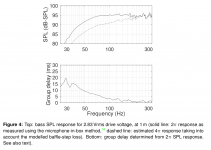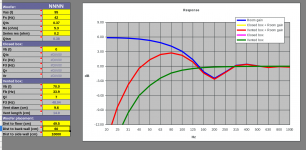Member
Joined 2009
Paid Member
I notice that Troels has updated his website article today, providing some additional information on this project.
I have to say, this might be the first project of his that gets my cheque-book out of the safe.
I have to say, this might be the first project of his that gets my cheque-book out of the safe.
I've already done some of his project....but this one is particularly appealing!!!! 🙂
Waiting for the first builder review!
Waiting for the first builder review!

Member
Joined 2009
Paid Member
I’ve started looking for a local supplier for the drivers. It looks like Faital has a distributor in New Jersey as their designated contact for Canada. Pitty that Q Components in Waterloo Ontario were not carrying them.
If I go fwd I will buy the full kit, I simply don’t have the time to mess about with everything myself, especially as I have a new Class A solid state amplifier design cooking in Spice. I don’t need any further builder’s reports since my own ears are the only final arbiter for speakers that have proved reliable so far.
If I go fwd I will buy the full kit, I simply don’t have the time to mess about with everything myself, especially as I have a new Class A solid state amplifier design cooking in Spice. I don’t need any further builder’s reports since my own ears are the only final arbiter for speakers that have proved reliable so far.
Last edited:
Well, someone has to be the first to find out, that there's remarkably little bass coming out of this 100 liter cabinet despite the expensive 12" woofer! 😀
Some have been doing it for long enough that we don't need to hear it to have a good idea what it will sound like, know where he's made compromises and where I (the Royal I) would do it differently. He's also approaching his designs from a commercial viewpoint, so he can sell lots of his xovers full of overpriced boutique parts of questionable efficacy.Also I am amazed at the amount of criticism of Troel's design based on little - if any - direct experience of the design.
To shine some light on the bass tuning, here's the measured SPL curve of the Faital 12PR320 (no xover). The box volume was pretty much the same as Troels design, and port tuning was very similar too.
You'll have to consider the baffle-step compensation that is needed to get the bass response right, and what this means in terms of overall system efficiency that is left after baffle-step compensation.
Edit / notes:
(1) Measurement method: R H Small. Simplified loudspeaker measurements at low frequencies. Journal
of Audio Engineering Society (JAES), 20:28–33, 1972.
(2) Baffle step was calculated by Tolvan Edge
You'll have to consider the baffle-step compensation that is needed to get the bass response right, and what this means in terms of overall system efficiency that is left after baffle-step compensation.
Edit / notes:
(1) Measurement method: R H Small. Simplified loudspeaker measurements at low frequencies. Journal
of Audio Engineering Society (JAES), 20:28–33, 1972.
(2) Baffle step was calculated by Tolvan Edge
Attachments
Last edited:
Well, someone has to be the first to find out, that there's remarkably little bass coming out of this 100 liter cabinet despite the expensive 12" woofer! 😀
That is typical of pro type woofers.If you want sensitivity you have to sacrifice some bass extension.But it is really not that bad.Minus 4 db at 40 hz minus 5 at 30hz. I would much rather have that than the typical small woofer based boom box which has big port /resonant frequency based lump at say 50hz just to achieve minus 3db bass of 30hz.
Member
Joined 2009
Paid Member
Since this design is aimed at folk that are indeed looking for above average sensitivity without the usual big horn options, and hence because they maybe using valve amplifiers one might also ask how does the bass change when using an with a lower than average damping factor ?
That is typical of pro type woofers.If you want sensitivity you have to sacrifice some bass extension.But it is really not that bad.Minus 4 db at 40 hz minus 5 at 30hz. I would much rather have that than the typical small woofer based boom box which has big port /resonant frequency based lump at say 50hz just to achieve minus 3db bass of 30hz.
Well the alignment above shows much worse extension than that Troels is depending on room gain to get him where he wants to go. Nothing wrong with that and also nothing wrong with adding a sub for the really low stuff.
Well the alignment above shows much worse extension than that Troels is depending on room gain to get him where he wants to go. Nothing wrong with that and also nothing wrong with adding a sub for the really low stuff.
Those figures I quoted are from the updated information and are without room gain.I agree that with room gain the lower bass would be more extended.
Many of us have rooms that are best suited to speakers that do rely on room gain to fill out the lower bass..
Speakers like my old Gale 401s for example.
It tends to be the speakers that ignore room gain effects that tend to not work well/overdrive/sound boomy in a lot of rooms.Why so many people end up using foam bungs in the ports which is just silly because the drivers are rarely designed to work properly in a sealed box.And especially not in one of that box volume.
Model it.and hence because they maybe using valve amplifiers one might also ask how does the bass change when using an with a lower than average damping factor ?
...because they maybe using valve amplifiers one might also ask how does the bass change when using an with a lower than average damping factor ?
The attenuation is determined by the ratio of the output resistance and the speaker impedance. With the speaker impedance minima of 5 Ohm at 45 Hz and 700 Hz and an assumed amp output resistance of 1 Ohm, the attenuation would be 5/(1+5) = 1.6 dB at these frequencies.
Room gain may well be part of the equation with many speakers. However, I don't think that Troels design is suitable for near-wall setup because the bass reflex ports are at the rear. I would therefore not count on a lot of room gain.
Room gain may well be part of the equation with many speakers. However, I don't think that Troels design is suitable for near-wall setup because the bass reflex ports are at the rear. I would therefore not count on a lot of room gain.
Near-wall and direct-to-wall placement is different in my view, the latter maybe problematic because of port breath restrictions from a too close wall, but my guess is that a 15-20 cm from the wall is enough distance for this speaker.
Anyway, you can place the ports on the front with a little effort.
^I just had a look at the bass boost from the room using the same tool that Troels uses (you can download it from Troels' website). I don't know what parameters he assumed for his curves, but here's mine. I assumed 20cm between the rear of the loudspeaker and the rear wall (as suggested by YSDR), and the woofer elevated from the floor as it would be with Troels stands (parameters as shown on the attachment). The curve looks a bit wild, and very different to Troels' curve. Also, the plain "no-room" curve is different from that shown in Troels' figure. I don't really know what to make of this.
The room curve shows a boost below 130 Hz. However, the baffle step starts at 600 Hz or so. The room boost will therefore not work well to compensate the baffle step loss between 130 to 600 Hz.
Does someone have an x-over modeling tool? It would be interesting to see a (modeled) transfer curve of the woofer filter in order to better understand if/how the baffle step compensation was implemented. Oh, no, wait, we don't know the x-over part values...
The room curve shows a boost below 130 Hz. However, the baffle step starts at 600 Hz or so. The room boost will therefore not work well to compensate the baffle step loss between 130 to 600 Hz.
Does someone have an x-over modeling tool? It would be interesting to see a (modeled) transfer curve of the woofer filter in order to better understand if/how the baffle step compensation was implemented. Oh, no, wait, we don't know the x-over part values...
Attachments
@ mbrennwa
Your simulation not looks bad at all, it's within +/- 3 dB down to about 30 Hz with the room gain.
Your simulation not looks bad at all, it's within +/- 3 dB down to about 30 Hz with the room gain.
Last edited:
Member
Joined 2009
Paid Member
Member
Joined 2009
Paid Member
"Back in the day" Acoustic Research - AR - built a two-panel front baffle with a fixed baffle for the 12" woofer, plus a separate baffle board for the tweeter+midrange which could be rotated 90-degrees for cabinet side placement in large bookcases. Just add a baffle step boost ckt + switch.
My first hi-fi was based on Acoustic Research AR38's. They were single baffle but they produced a very satisfying sound. I so regret having got rid of those after the woofer foam surrounds rotted. I was not into DIY back then and didn't consider getting them repaired - I left them on the front porch for the local charity guys to pick-up. At the time I bought them, I was a poor student but they did great duty at University Hall of Residence - every Sunday was pizza day and everyone in the Residence tuned in to the British top 40 on Radio 1 and cranked their systems to '11'.
As fate would have it, my employer is now Teledyne, who at one time was the owner of Acoustic Research.
I had the 'rotating' version when a student in Dublin. They were not too impressive so I traded them for a pair of Tannoy IIIZ - they weren't any better. Of course in those days I knew zilch about setting up speakers...they were bought second hand for £30 (IIIZ) & £35.00 (ARs).
[Which makes me think that Bigun is somewhat older than I supposed! 😛]
[Which makes me think that Bigun is somewhat older than I supposed! 😛]
Member
Joined 2009
Paid Member
[Which makes me think that Bigun is somewhat older than I supposed! 😛]
Young at heart my friend 😀
But I'm past my half-century...
- Home
- Loudspeakers
- Multi-Way
- Troels Gravesen high efficiency 3-way looks like a winner.

